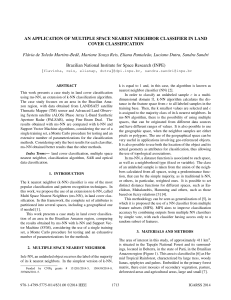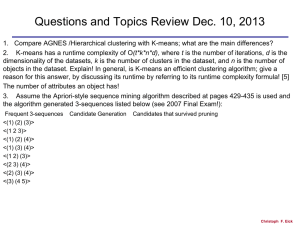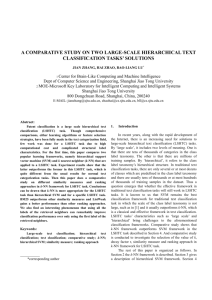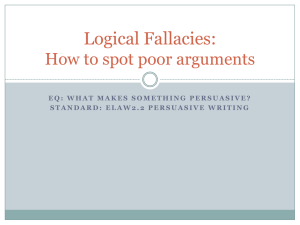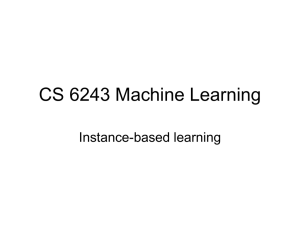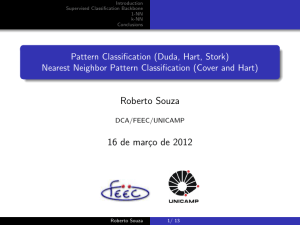Review Questions for December 1
advertisement
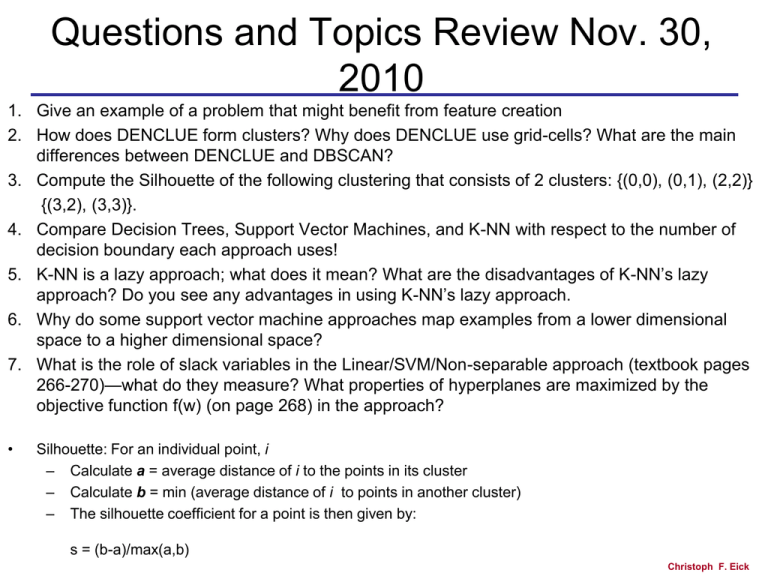
Questions and Topics Review Nov. 30,
2010
1. Give an example of a problem that might benefit from feature creation
2. How does DENCLUE form clusters? Why does DENCLUE use grid-cells? What are the main
differences between DENCLUE and DBSCAN?
3. Compute the Silhouette of the following clustering that consists of 2 clusters: {(0,0), (0,1), (2,2)}
{(3,2), (3,3)}.
4. Compare Decision Trees, Support Vector Machines, and K-NN with respect to the number of
decision boundary each approach uses!
5. K-NN is a lazy approach; what does it mean? What are the disadvantages of K-NN’s lazy
approach? Do you see any advantages in using K-NN’s lazy approach.
6. Why do some support vector machine approaches map examples from a lower dimensional
space to a higher dimensional space?
7. What is the role of slack variables in the Linear/SVM/Non-separable approach (textbook pages
266-270)—what do they measure? What properties of hyperplanes are maximized by the
objective function f(w) (on page 268) in the approach?
•
Silhouette: For an individual point, i
– Calculate a = average distance of i to the points in its cluster
– Calculate b = min (average distance of i to points in another cluster)
– The silhouette coefficient for a point is then given by:
s = (b-a)/max(a,b)
Christoph F. Eick
Support Vector Machines
•
What if the problem is not linearly separable?
Christoph F. Eick
Linear SVM for Non-linearly Separable Problems
What if the problem is not linearly separable?
Parameter
– Introduce slack variables
2
N
||
w
||
k
Need to minimize:
L( w)
C i
2
i 1
Inverse size of margin
between hyperplanes
Slack variable
Subject to (i=1,..,N):
(1)
( 2)
Measures testing error
yi * (w x i b) 1 - i
0 i
allows constraint violation
to a certain degree
C is chosen using a validation set trying to keep
the margins wide while keeping the training error low.
Tan, Steinbach, Kumar, Eick: NN-Classifiers and Support Vector Machines
Questions and Topics Review Nov. 30,
2010
1. Discussion of Problem1/2of Assignment4
2. Give an example of a problem that might benefit from feature creation
3. How does DENCLUE form clusters? Why does DENCLUE use grid-cells? What are the main
differences between DENCLUE and DBSCAN?
4. Compute the Silhouette of the following clustering that consists of 2 clusters: {(0,0), (0.1), (2,2)}
{(3,2), (3,3)}.
6. Compare Decision Trees, Support Vector Machines, and K-NN with respect to the number of
decision boundary each approach uses!
DT: many, rectangular for numerical attributes K-NN: many, convex polygons (Voronoi cells),
SVM: one, hyperplane
6. K-NN is a lazy approach; what does it mean? What are the disadvantages of K-NN’s lazy
approach? Do you see any advantages in using K-NN’s lazy approach.
… advantages: for quickly changing streaming data learning the model might be a waste of time
and a lazy approach might be better…
7. Why do some support vector machine approaches map examples from a lower dimensional
space to a higher dimensional space?
To make them linearly separable.
7. What is the role of slack variables in the Linear/SVM/Non-separable approach (textbook pages
266-270)—what do they measure? What properties of hyperplanes are maximized by the
objective function f(w) (on page 268) in the approach?
Christoph F. Eick
